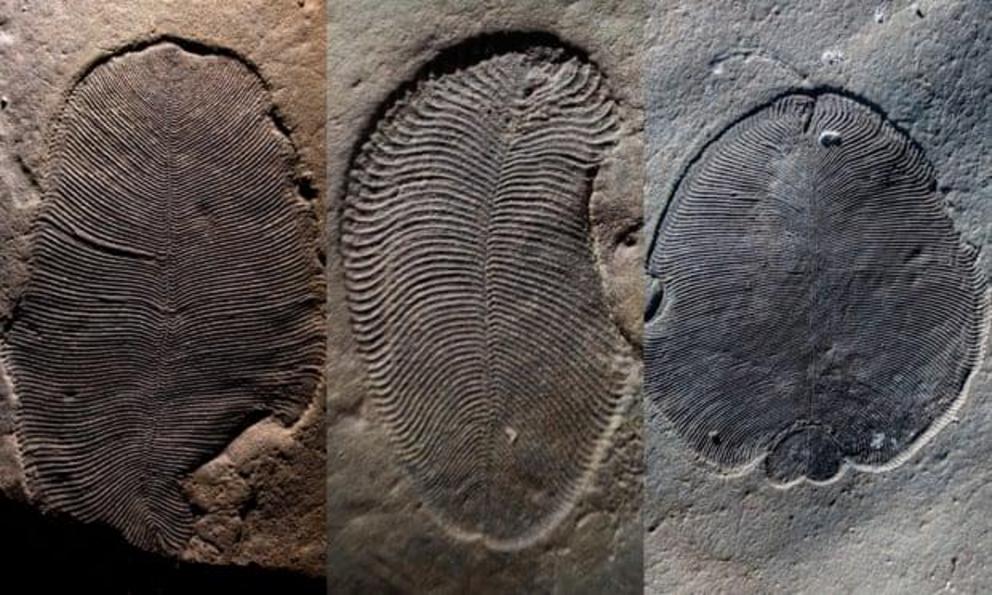558m-year-old fossils identified as oldest known animal
A fossilised lifeform that existed 558m years ago has been identified as the oldest known animal, according to new research.
The findings confirm that animals existed at least 20m years before the so-called Cambrian explosion of animal life, which took place about 540m years ago and saw the emergence of modern-looking animals such as snails, bivalves and arthropods.
The new fossils, of the genus Dickinsonia, are the remains of an oval-shaped lifeform and part of an ancient and enigmatic group of organisms called Ediacarans. These creatures are some of the earliest complex organisms on Earth, but their place within the evolutionary tree has long puzzled scientists. Suggestions as to what they were have ranged from lichens to failed evolutionary experiments to bacterial colonies.
Now, by identifying the remains of organic matter on newly discovered Ediacaran fossils as ancient cholesterol, the scientists have been able to confirm Dickinsonia was an animal, which makes it the oldest known animal.
“It is the exact type and composition of that fat that was the giveaway that Dickinsonia was in fact an animal,” said Jochen Brocks of the Australian National University, one of the authors on the study. He added that the study solves “a decades-old mystery that has been the holy grail of palaeontology”.
The fossils were discovered on two surfaces on a cliffside in the remote wilderness of north-west Russia by PhD student Ilya Bobrovskiy, who is lead author on the paper, published in the journal Science.

The cliffs in which the fossils were found, on the coast of the White Sea in Russia. Photograph: Ilya Bobrovskiy
“I took a helicopter to reach this very remote part of the world – home to bears and mosquitoes – where I could find Dickinsonia fossils with organic matter still intact,” Bobrovskiy said.
“These fossils were located in the middle of cliffs of the White Sea that are 60-100m high. I had to hang over the edge of a cliff on ropes and dig out huge blocks of sandstone, throw them down, wash the sandstone and repeat this process until I found the fossils I was after.”
Charlotte Kenchington, a palaeobiologist based at the University of Cambridge, said: “It’s really, really unusual to have preservation of organic matter in the Ediacaran. The really neat thing about this study is that they’ve analysed both the sediment around the fossil and the fossil itself.
“The biomarker signal of the sediment is very different to the biomarker signal of the organic matter associated with the fossil. This gives you a huge deal of confidence in the results.”
Emily Mitchell, also of the University of Cambridge, who works on Ediacaran animals preserved in the UK and Newfoundland, described the find as “incredibly exciting” but said there is still a huge amount that we don’t know about the Ediacarans.
She said: “Now we know that animal life started before the Cambrian, in the Ediacaran. That’s very clear now in a way that it wasn’t 15 years ago. But they still look very different to modern animals. The transition between Dickinsonia to even the animals you find in the Cambrian is still quite a large one – we’re still not clear how that happened, for example.”
This is not the first study to suggest some Ediacaran creatures were animals. Recent studies have shown that rangeomorphs, a bizarre group of branched organisms, were also animal-like. “It’s quite exciting to see multiple, different lines of evidence all suggesting that various Ediacaran species were animals,” said Mitchell.
Ultimately, Brocks said, understanding “what these strange-looking Ediacaran creatures really were ... is essential if we want to understand the emergence and evolution of our own earliest ancestors.”

